Unit 4 Body language Warming up and Reading 课件(30张PPT)
文档属性
| 名称 | Unit 4 Body language Warming up and Reading 课件(30张PPT) |
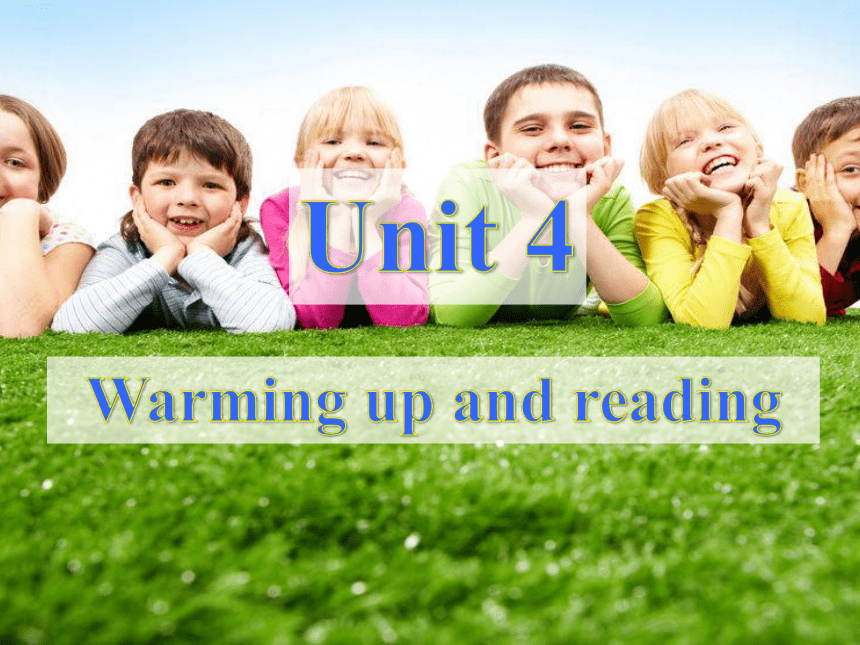
|
|
| 格式 | zip | ||
| 文件大小 | 3.2MB | ||
| 资源类型 | 教案 | ||
| 版本资源 | 人教版(新课程标准) | ||
| 科目 | 英语 | ||
| 更新时间 | 2019-11-16 22:40:14 | ||
图片预览

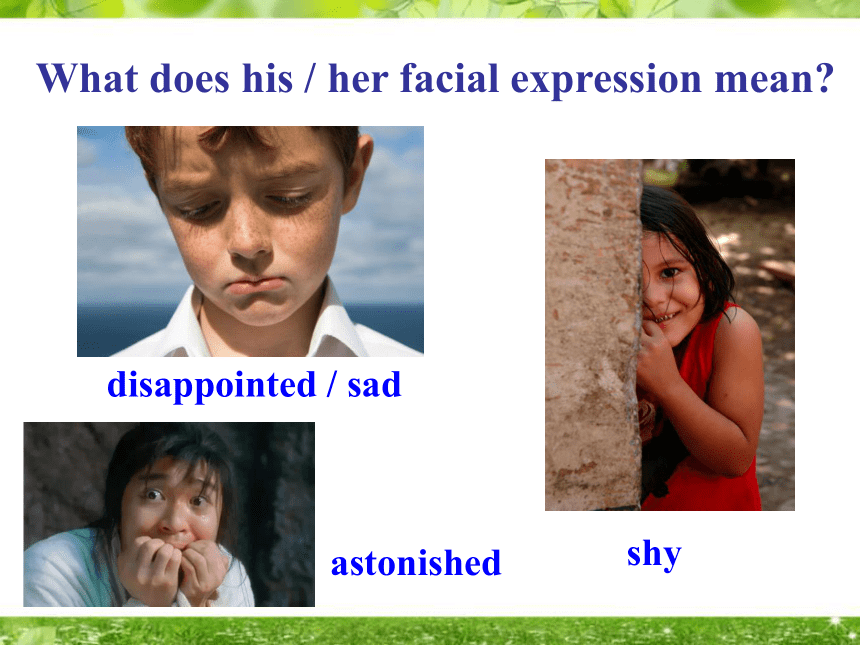
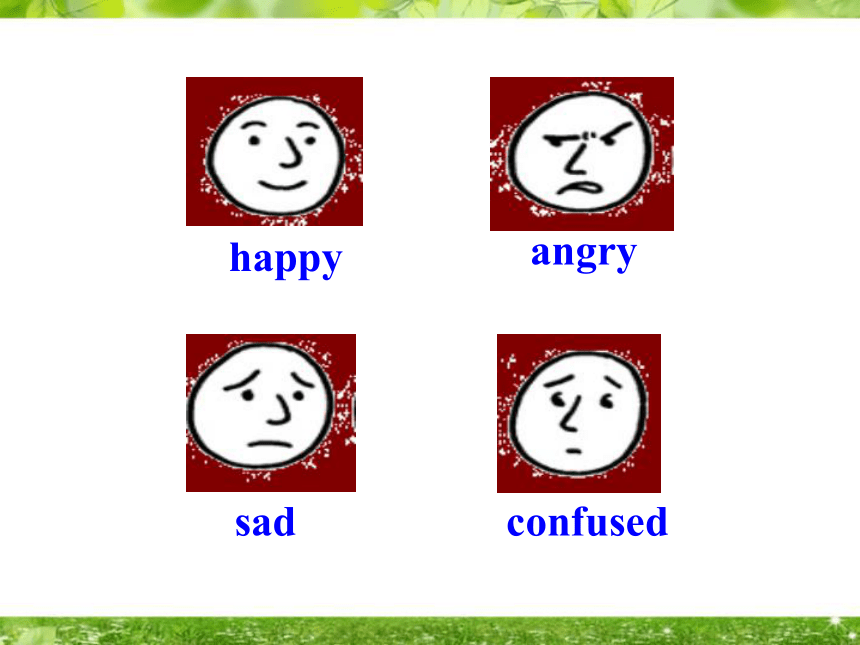
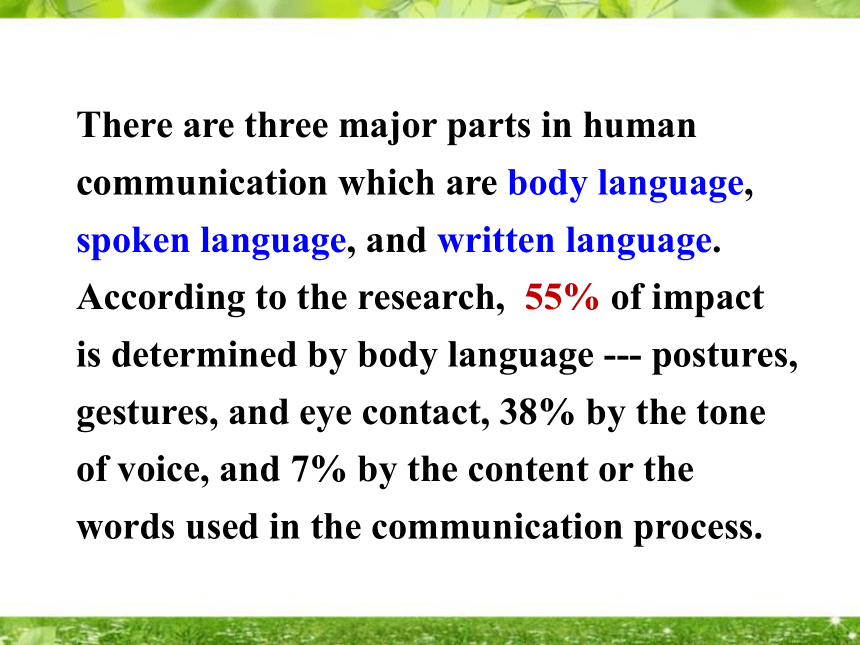

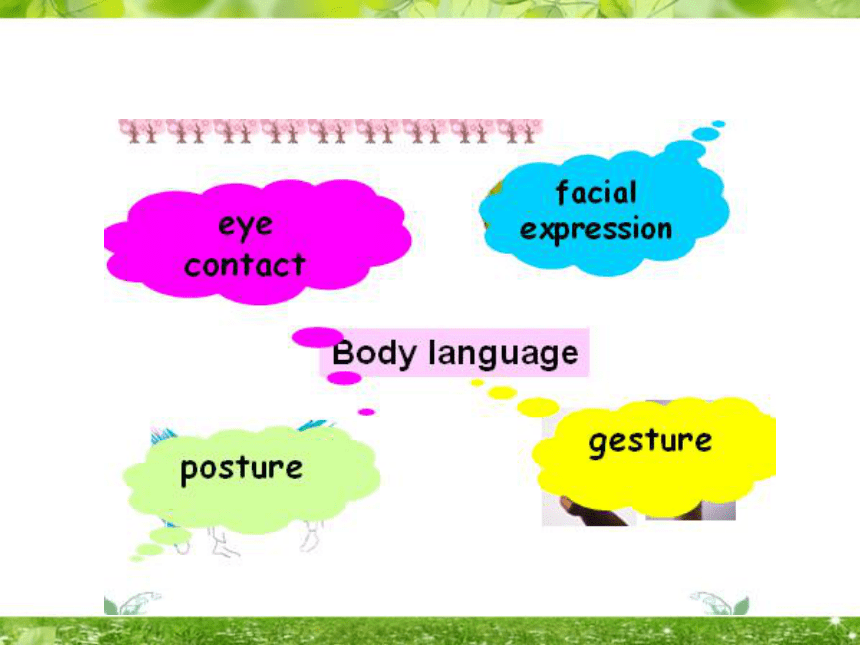
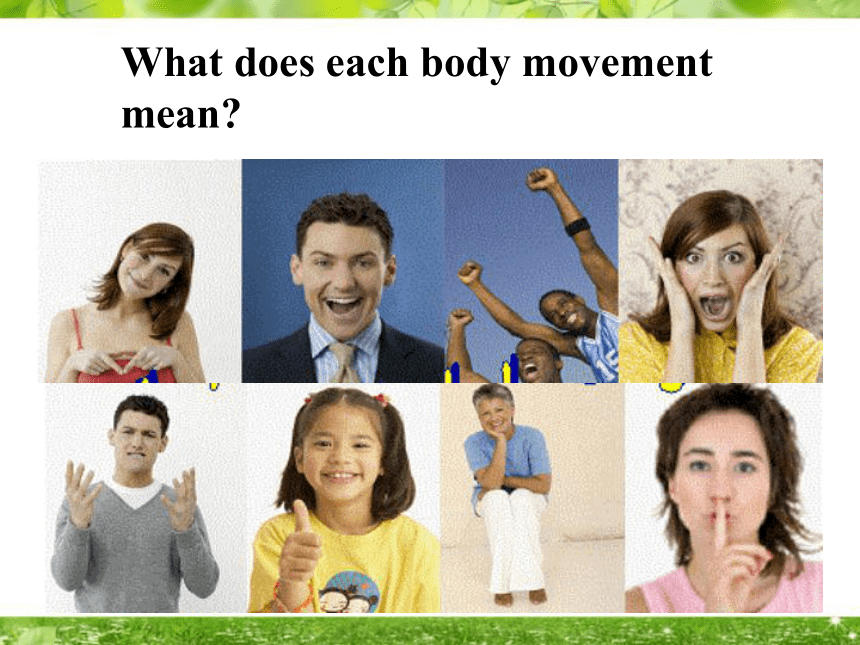
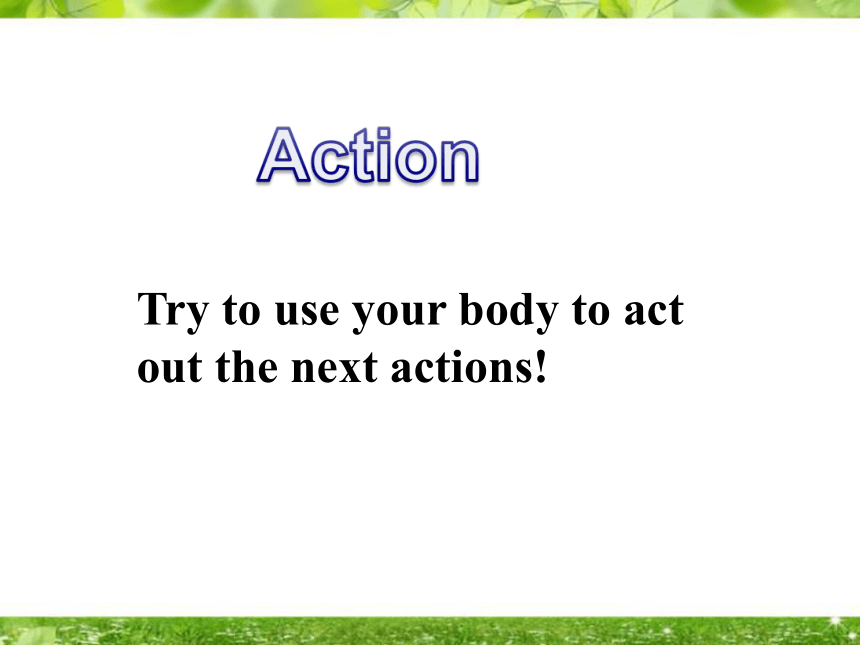

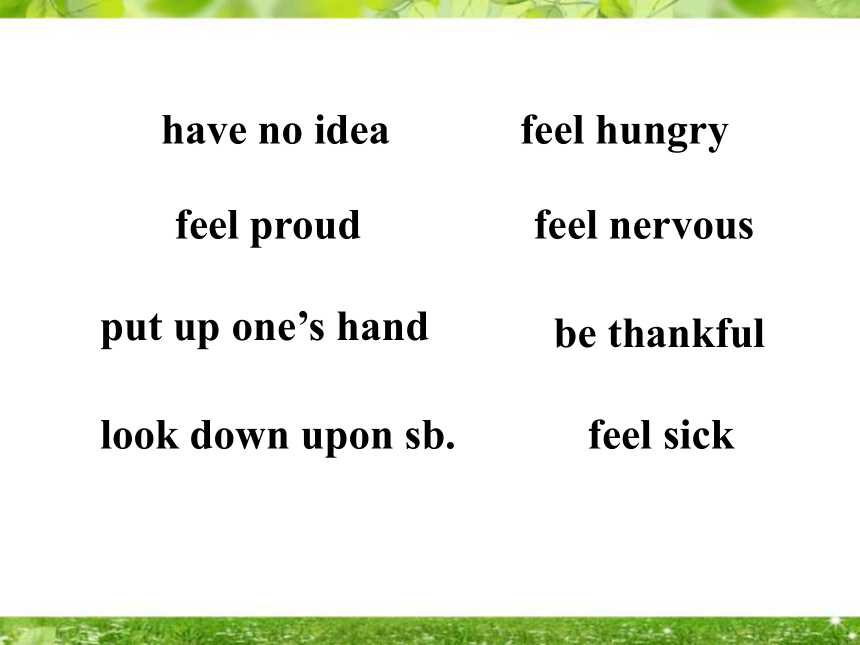
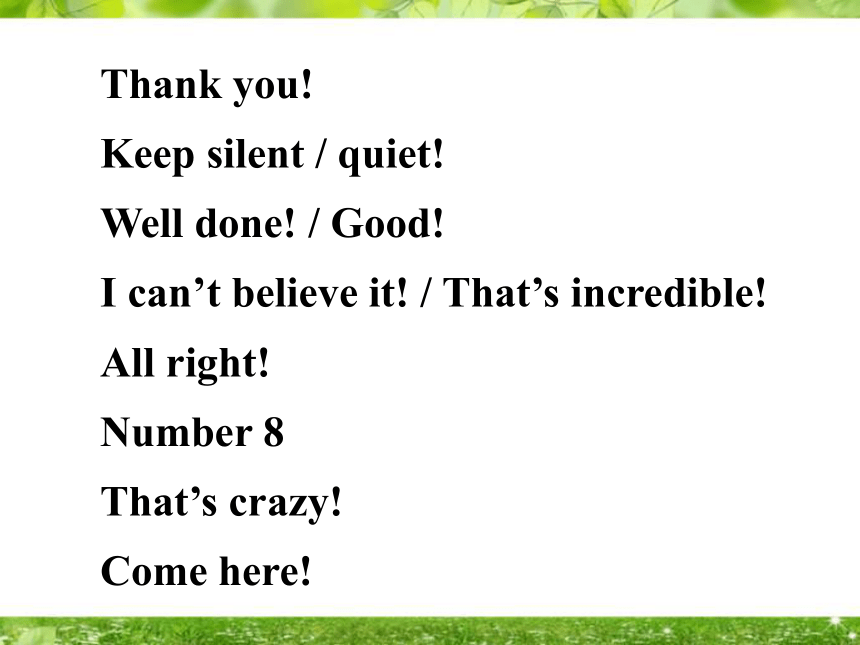
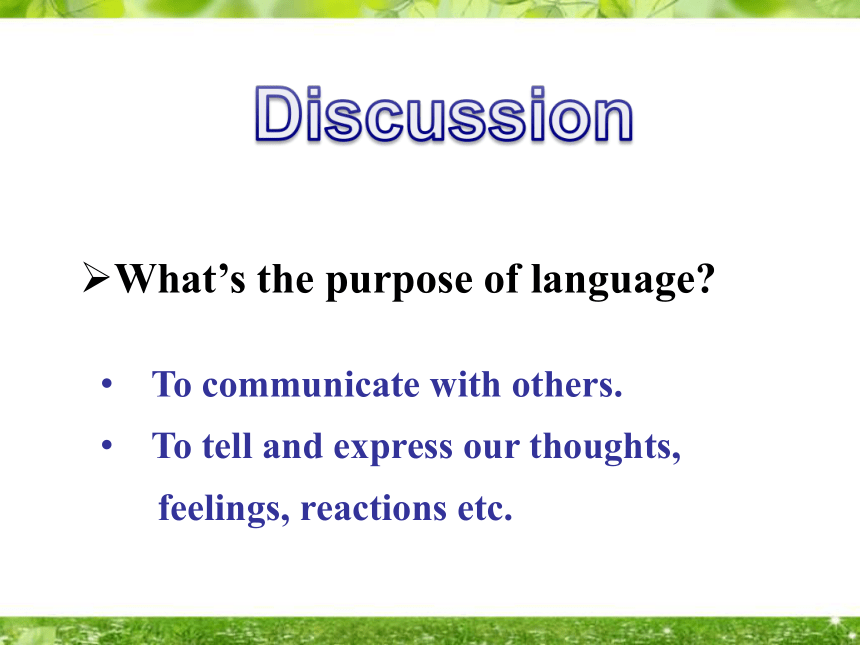
文档简介
(共30张PPT)
disappointed / sad
shy
astonished
What does his / her facial expression mean?
sad
confused
happy
angry
There are three major parts in human communication which are body language, spoken language, and written language. According to the research, 55% of impact is determined by body language --- postures, gestures, and eye contact, 38% by the tone of voice, and 7% by the content or the words used in the communication process.
Body Language is a form of non-verbal communication.
It uses movements or positions of our body to show other people what we are thinking or feeling.
It includes body movements, facial expressions, gestures, posture, speaking distance and other non-verbal signals.
What is body language?
What does each body movement mean?
Try to use your body to act out the next actions!
Stop!
Come here.
You are very good.
It’s OK.
Bye-bye.
be thankful
feel nervous
feel sick
put up one’s hand
look down upon sb.
feel proud
feel hungry
have no idea
Thank you!
Keep silent / quiet!
Well done! / Good!
I can’t believe it! / That’s incredible!
All right!
Number 8
That’s crazy!
Come here!
What’s the purpose of language?
To communicate with others.
To tell and express our thoughts,
feelings, reactions etc.
What does the gesture V mean?
In China, it means number 2.
In western countries, it means victory and success.
In Japan, it means peace.
Because of cultural differences, there are differences between the same body language.
What is the best example of
universal body language?
Smile is a bridge to the world!
Fast reading
What is the main idea of the passage?
Some examples of cultural body language in greeting people.
Find the characters and where they are from.
Julia Smith
Columbia
Canada
Ahmed Aziz
France
China
Britain
Japan
Jordan
Tony Garcia
George Cook
Akira Nagata
Darlene Coulon
I
Character Country
Find the word from the text for each of
these meanings.
_______ action of defending oneself against an enemy’s attack
______ might happen or probably will be true
_____ European country that is shaped like a boot.
_______ small restaurant provided by a school for its students or by a company for its employees
_________ to be chosen to speak or act in place of someone
defence
likely
Italy
canteen
represent
6. ______ to run or travel somewhere in a great hurry
7. _________ to come nearer to something or someone from a great distance
8. _________ group of people organized for a special purpose
9. ______ either side of the face below the eye
10. ______ the act of flying, especially scheduled on a plane
dash
approach
association
cheek
flight
Meet international students from several countries.
Not all cultures greet each other the same way.
A conclusion of the passage
Para 2
Para 4
Para 5
Para 1
Para 3
课文脉络图
Careful reading
How long did the writer wait at the
airport?
2. How did Julia behavior when Tony approached her?
3. What does the phrase cultural mistake mean?
Read again and answer the questions.
Half an hour.
People from different countries misunderstand each other.
She appeared surprised and put up her hands to defence.
Decide whether the statement is true or false.
1. Only Australia and central America are not represented by the visitors.
2. Not all cultures greet each other the same way, so people everywhere act the same.
3. Julia Smith is surprised because Mr. Garcia touches her shoulder and kisses her.
4. French people will often bow and kiss people they know on both cheeks.
5. The main character is female.
F
F
T
F
F
Find out the two mistakes the writer found in the airport.
Mr. Garcia
Julia Smith
The first mistake
from
from
( )
( )
He approaches Ms Smith by _______ ______ _________ and _______ her on the ________.
She ______ ________ appearing _________ and put up her hands _______ ______.
shoulder
touching
her
kissing
cheek
stepped back
surprised
in defence
Columbia
Britain
The second mistake
Akira Nagata
George Cook
from
( )
He ________ ______ _______ ________ to Akira Nagata.
He ________ to Mr. Cook and his nose _________ Mr. Cook’s _______ ________.
bowed
touched
moving
hand
reached
his hand
out
( )
from
Japan
Canada
What does the following sentence mean? What can we learn from the whole passage?
These actions are not good or bad.
Body language varies from culture to culture. Not all members of all cultures behave the same way. We should try to master and respect each other’s culture in order to make good communication.
Situation 1: Tony Garcia (Columbia, South America) meet Julia Smith (Britain, Europe)
Situation 2: George Cook (Canada, North America) meet Akira Nagata (East Asia)
Situation 3: Chinese (East Asia) meet Ahmed Aziz (Jordan, West Asia)
Situation 4: Darlene Coulon (France, West Europe) meet Tony Garcia (Columbia, South America )
If you go to travel in a Muslim country, what should you pay attention to according to the passage?
Four students come to the front and act out different gestures.
A. putting both hands in pockets (lazy)
B. crossing arms (self-assured, like a boss)
C. Looking around from time to time (paying no attention)
D. Standing straight with a smile
Review the passage and list the words and expressions you have difficulty with.
Homework
disappointed / sad
shy
astonished
What does his / her facial expression mean?
sad
confused
happy
angry
There are three major parts in human communication which are body language, spoken language, and written language. According to the research, 55% of impact is determined by body language --- postures, gestures, and eye contact, 38% by the tone of voice, and 7% by the content or the words used in the communication process.
Body Language is a form of non-verbal communication.
It uses movements or positions of our body to show other people what we are thinking or feeling.
It includes body movements, facial expressions, gestures, posture, speaking distance and other non-verbal signals.
What is body language?
What does each body movement mean?
Try to use your body to act out the next actions!
Stop!
Come here.
You are very good.
It’s OK.
Bye-bye.
be thankful
feel nervous
feel sick
put up one’s hand
look down upon sb.
feel proud
feel hungry
have no idea
Thank you!
Keep silent / quiet!
Well done! / Good!
I can’t believe it! / That’s incredible!
All right!
Number 8
That’s crazy!
Come here!
What’s the purpose of language?
To communicate with others.
To tell and express our thoughts,
feelings, reactions etc.
What does the gesture V mean?
In China, it means number 2.
In western countries, it means victory and success.
In Japan, it means peace.
Because of cultural differences, there are differences between the same body language.
What is the best example of
universal body language?
Smile is a bridge to the world!
Fast reading
What is the main idea of the passage?
Some examples of cultural body language in greeting people.
Find the characters and where they are from.
Julia Smith
Columbia
Canada
Ahmed Aziz
France
China
Britain
Japan
Jordan
Tony Garcia
George Cook
Akira Nagata
Darlene Coulon
I
Character Country
Find the word from the text for each of
these meanings.
_______ action of defending oneself against an enemy’s attack
______ might happen or probably will be true
_____ European country that is shaped like a boot.
_______ small restaurant provided by a school for its students or by a company for its employees
_________ to be chosen to speak or act in place of someone
defence
likely
Italy
canteen
represent
6. ______ to run or travel somewhere in a great hurry
7. _________ to come nearer to something or someone from a great distance
8. _________ group of people organized for a special purpose
9. ______ either side of the face below the eye
10. ______ the act of flying, especially scheduled on a plane
dash
approach
association
cheek
flight
Meet international students from several countries.
Not all cultures greet each other the same way.
A conclusion of the passage
Para 2
Para 4
Para 5
Para 1
Para 3
课文脉络图
Careful reading
How long did the writer wait at the
airport?
2. How did Julia behavior when Tony approached her?
3. What does the phrase cultural mistake mean?
Read again and answer the questions.
Half an hour.
People from different countries misunderstand each other.
She appeared surprised and put up her hands to defence.
Decide whether the statement is true or false.
1. Only Australia and central America are not represented by the visitors.
2. Not all cultures greet each other the same way, so people everywhere act the same.
3. Julia Smith is surprised because Mr. Garcia touches her shoulder and kisses her.
4. French people will often bow and kiss people they know on both cheeks.
5. The main character is female.
F
F
T
F
F
Find out the two mistakes the writer found in the airport.
Mr. Garcia
Julia Smith
The first mistake
from
from
( )
( )
He approaches Ms Smith by _______ ______ _________ and _______ her on the ________.
She ______ ________ appearing _________ and put up her hands _______ ______.
shoulder
touching
her
kissing
cheek
stepped back
surprised
in defence
Columbia
Britain
The second mistake
Akira Nagata
George Cook
from
( )
He ________ ______ _______ ________ to Akira Nagata.
He ________ to Mr. Cook and his nose _________ Mr. Cook’s _______ ________.
bowed
touched
moving
hand
reached
his hand
out
( )
from
Japan
Canada
What does the following sentence mean? What can we learn from the whole passage?
These actions are not good or bad.
Body language varies from culture to culture. Not all members of all cultures behave the same way. We should try to master and respect each other’s culture in order to make good communication.
Situation 1: Tony Garcia (Columbia, South America) meet Julia Smith (Britain, Europe)
Situation 2: George Cook (Canada, North America) meet Akira Nagata (East Asia)
Situation 3: Chinese (East Asia) meet Ahmed Aziz (Jordan, West Asia)
Situation 4: Darlene Coulon (France, West Europe) meet Tony Garcia (Columbia, South America )
If you go to travel in a Muslim country, what should you pay attention to according to the passage?
Four students come to the front and act out different gestures.
A. putting both hands in pockets (lazy)
B. crossing arms (self-assured, like a boss)
C. Looking around from time to time (paying no attention)
D. Standing straight with a smile
Review the passage and list the words and expressions you have difficulty with.
Homework
同课章节目录
